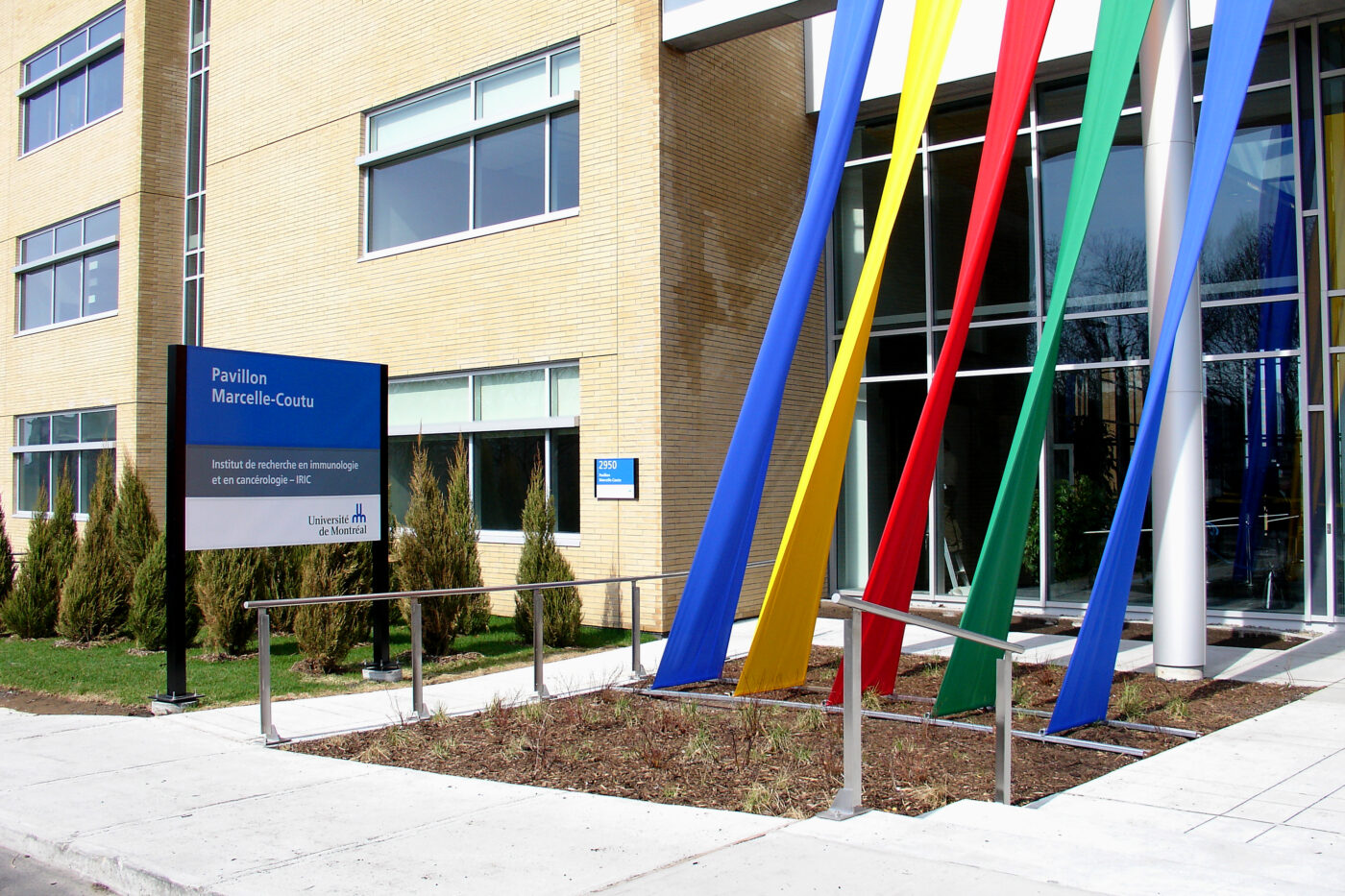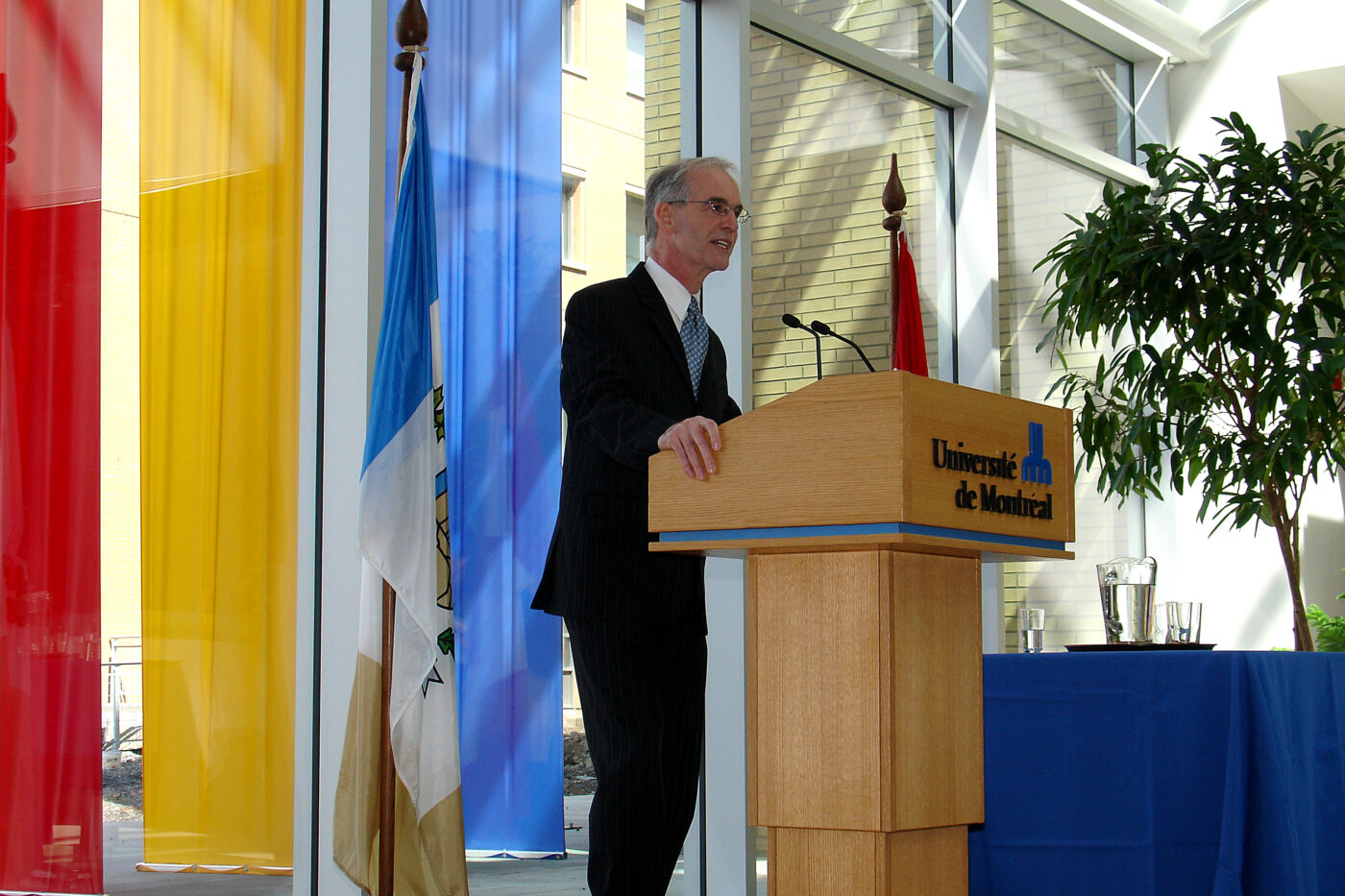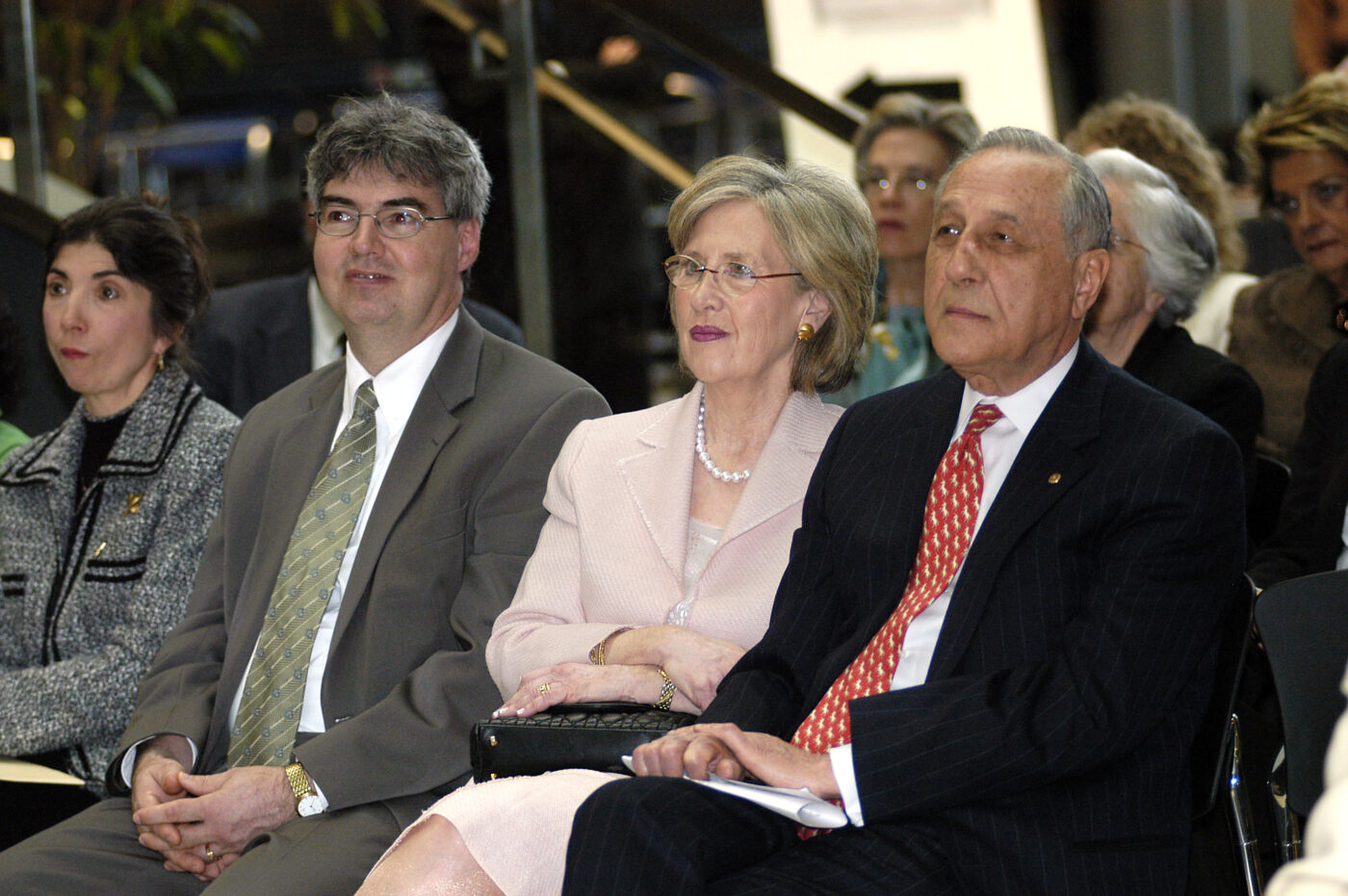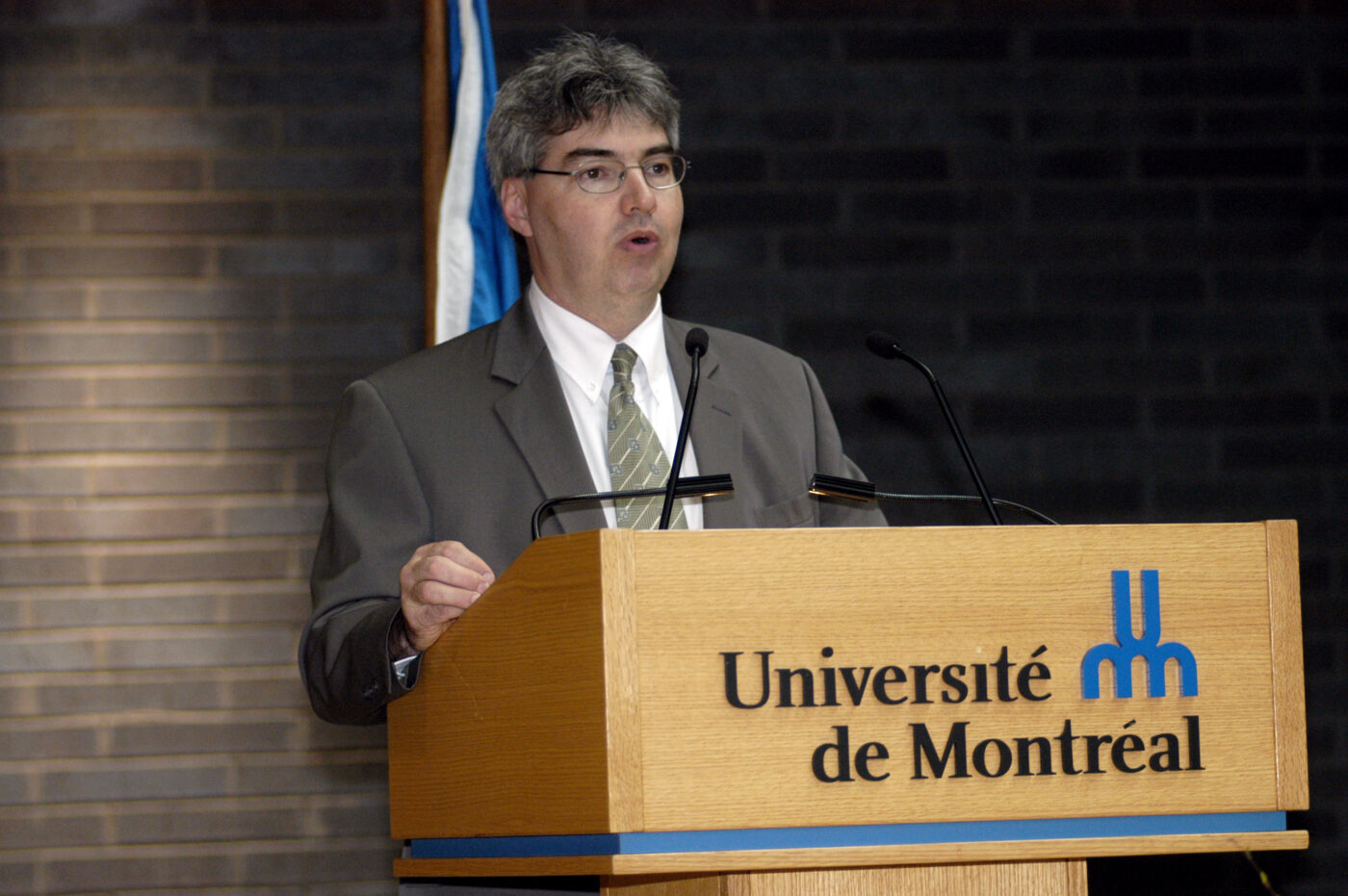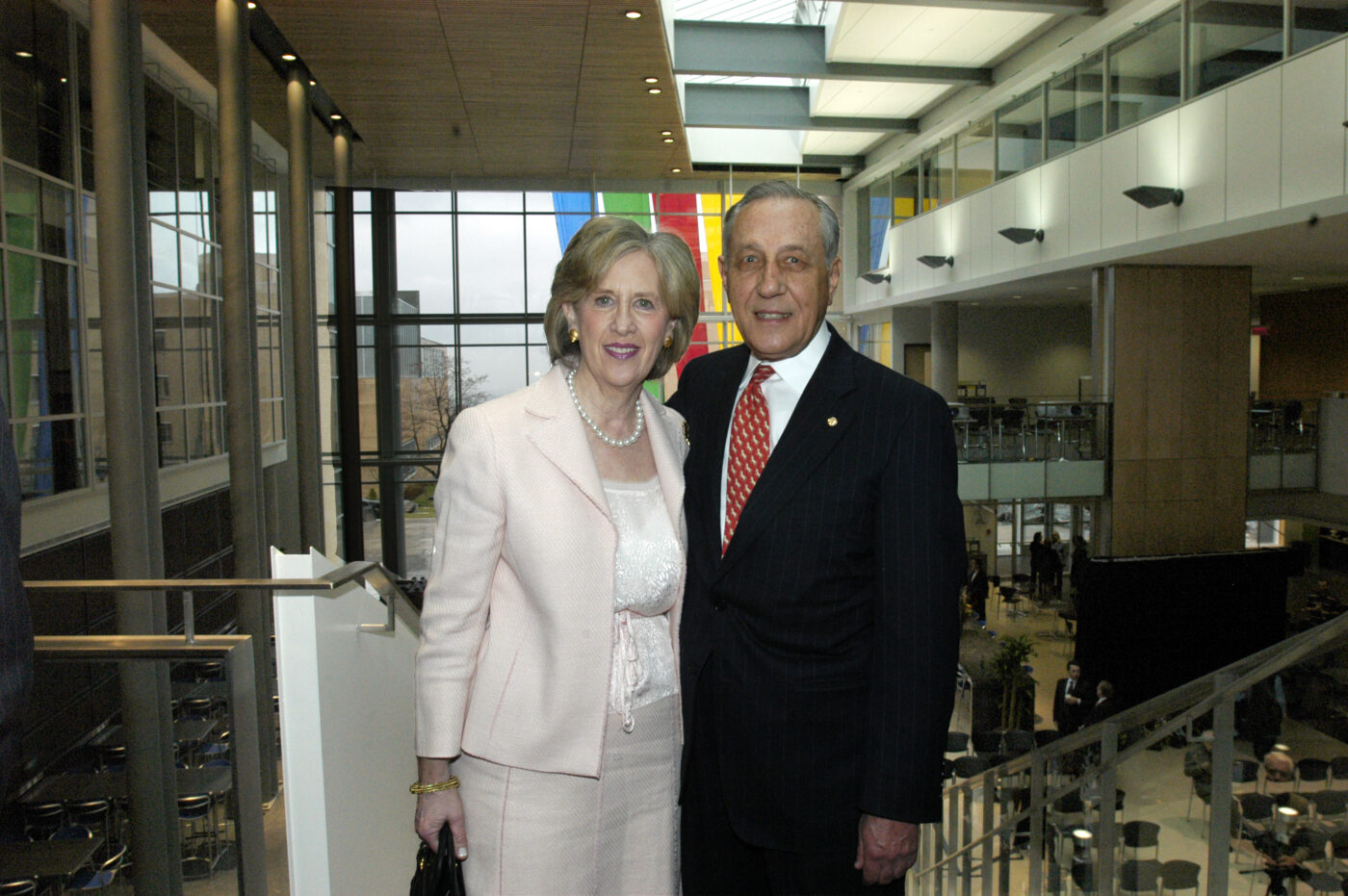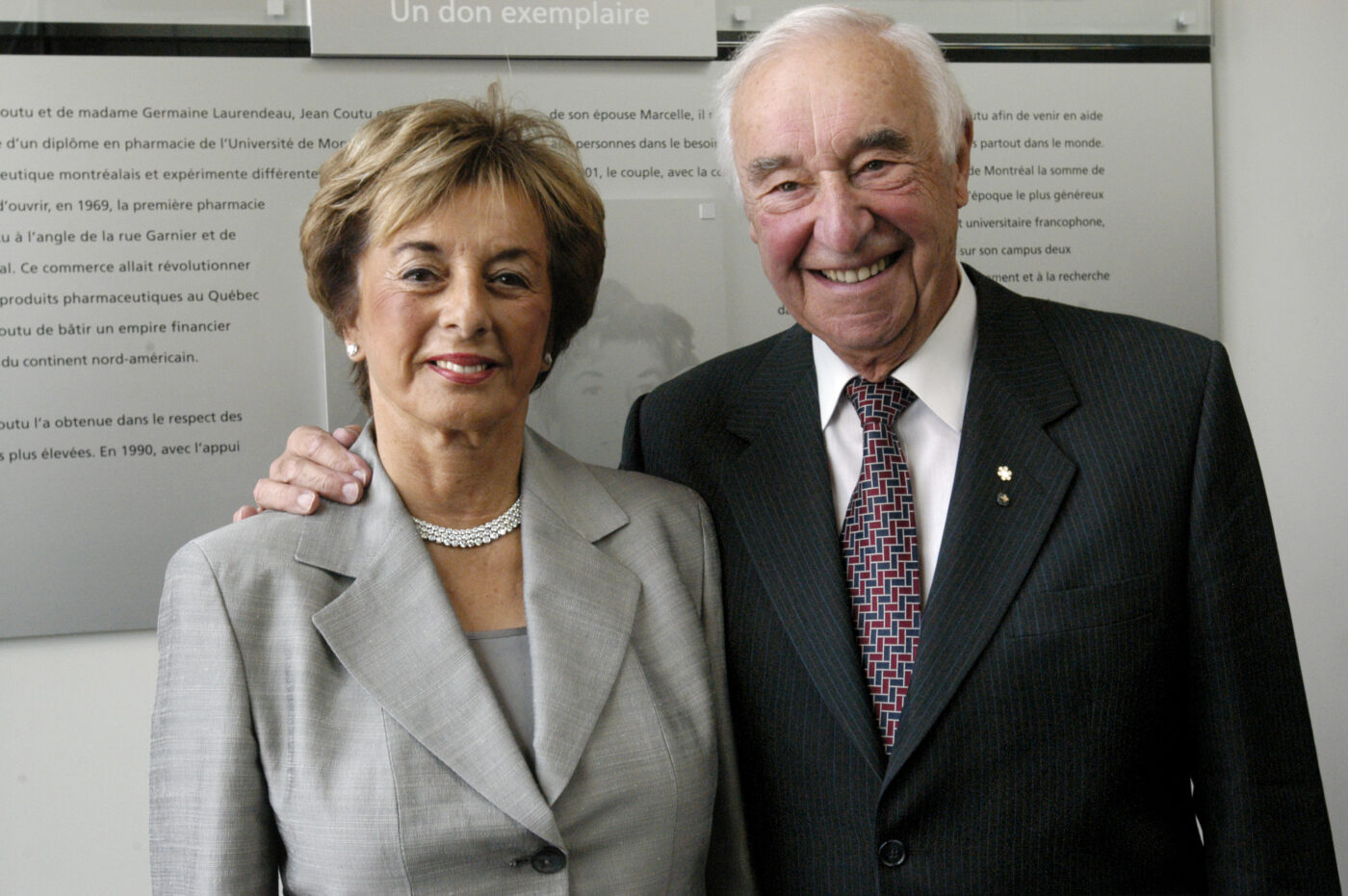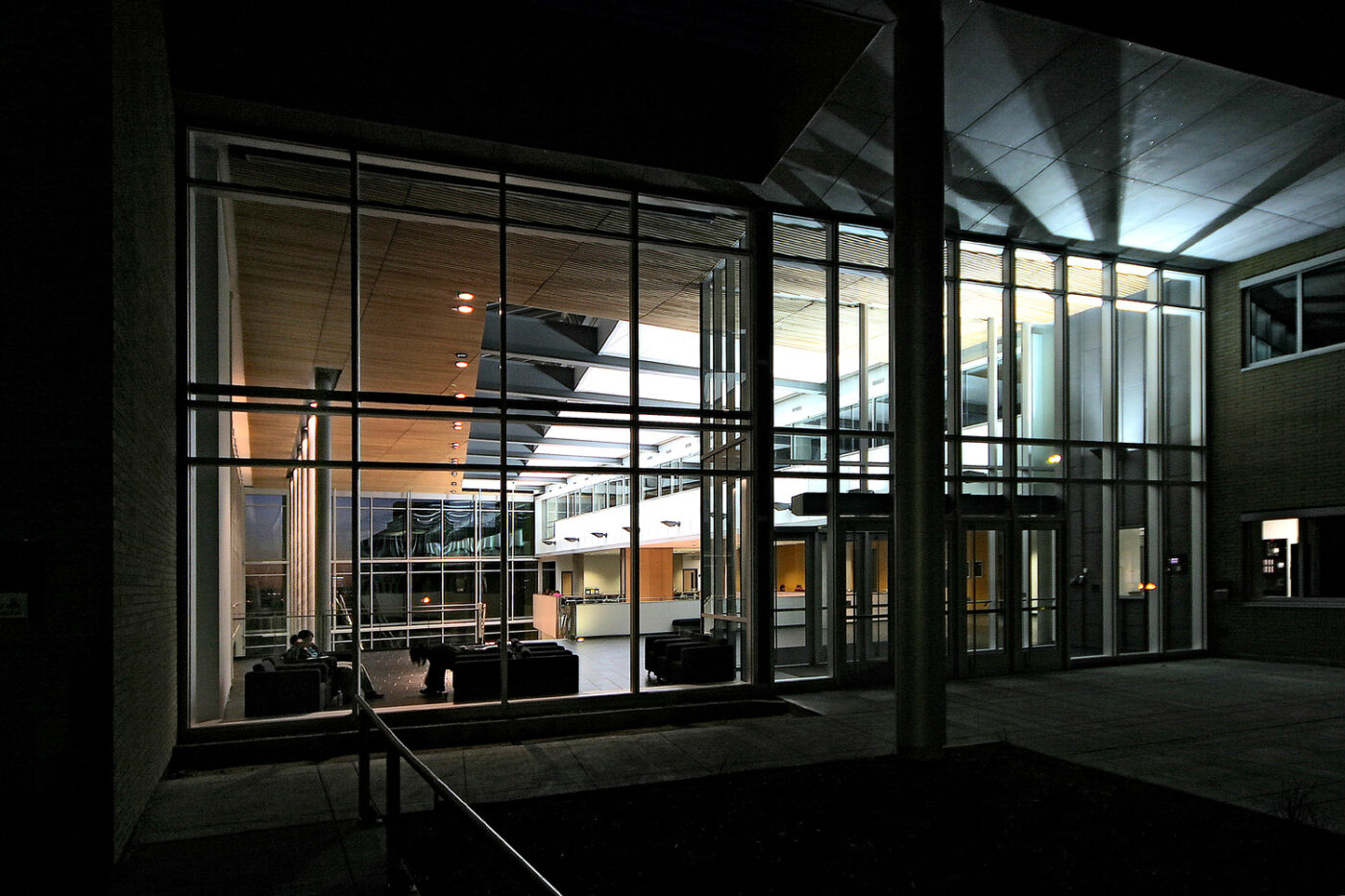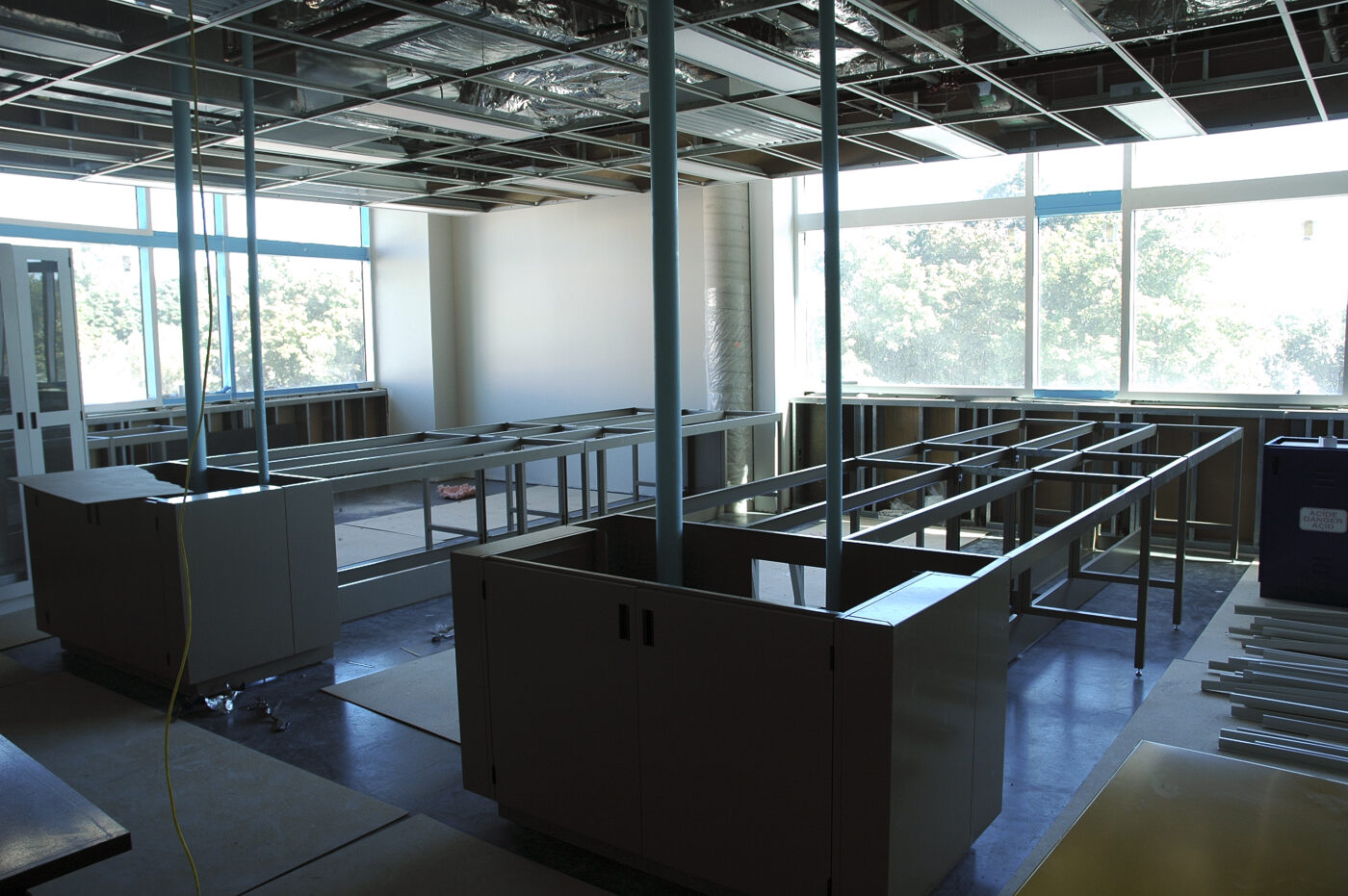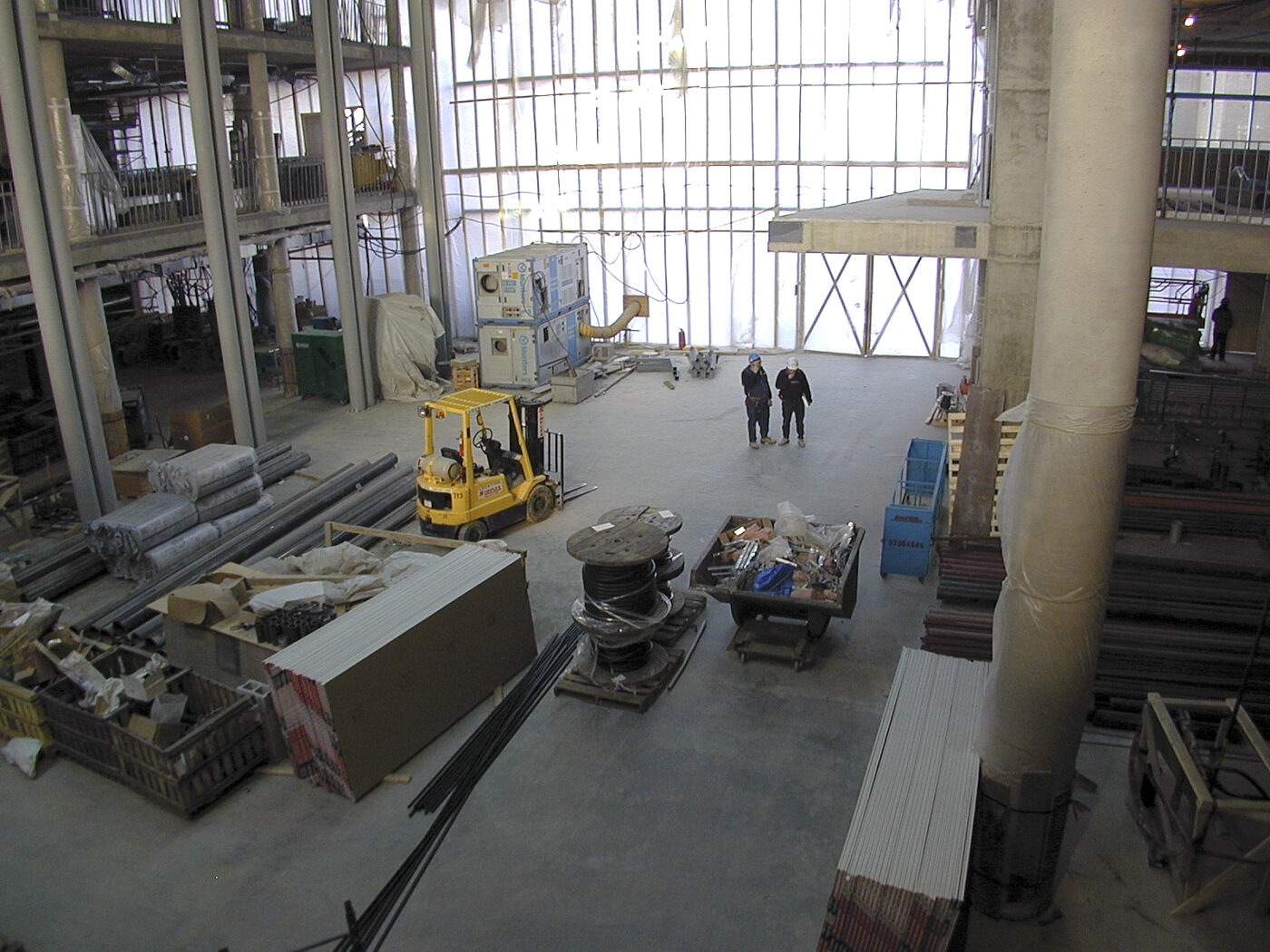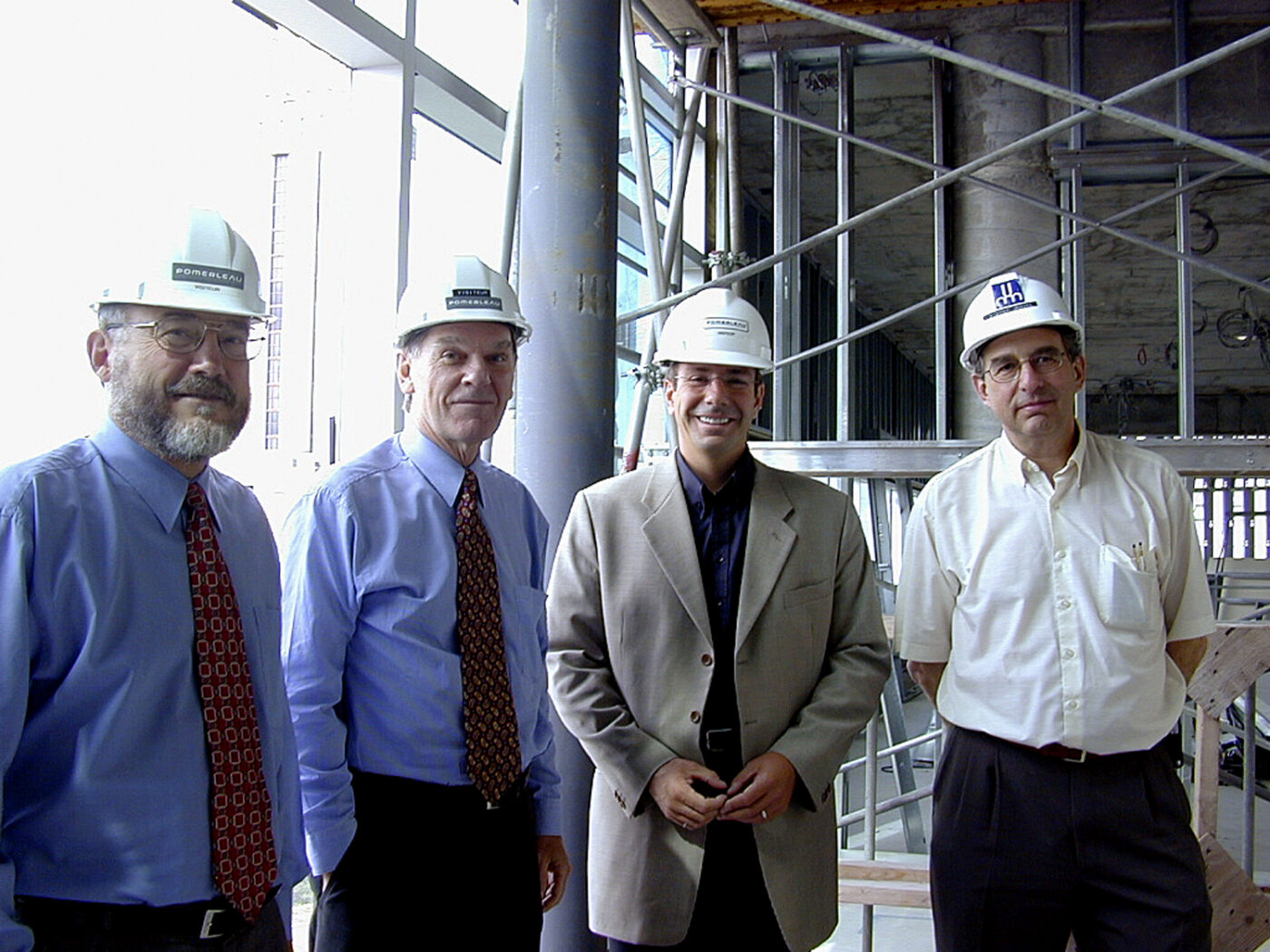News
Jean-Coutu and Marcelle-Coutu pavilions: 20 years ago, a dream came true
Published on May 21, 2025
On April 26, 2005, the two pavilions were inaugurated to house the Université de Montréal’s Faculty of Pharmacy and Institute for Research in Immunology and Cancer (IRIC), respectively.
The story begins with a dream evoked aloud, a phrase thrown out at the end of a conversation, a perch that might well have been missed. It’s 2001, and as part of the Grande campagne, Claude Mailhot, vice-dean, and Robert Goyer, former dean of the Faculty of Pharmacy and now in charge of the campaign, visit Jean Coutu to ask for his help in creating a research chair in geriatrics. Mr. Coutu listened attentively, but the meeting ended without a decision.
As he prepares to leave the office, Mr. Goyer pulls a final card from his pocket. He explains that he has a dream that he describes as “unrealistic and unattainable”. He wants the Faculty of Pharmacy to have its own “home”, its own space. At the time, the faculty was housed in the Pavillon Roger-Gaudry, and its premises were spread over several floors. It was cramped and scattered.
The dean at the time, Jacques Turgeon, recalls that the faculty was preparing to offer an undergraduate doctorate (Pharm.D.), a first in Canada, and to create a Bachelor of Pharmaceutical Sciences (BSBP) program, programs focused on skill development supported by innovative pedagogical approaches. Not to mention the ambition to become a cutting-edge research facility. These projects required space. Plenty of space.
Mr. Coutu promises to think about it. “I will get back to you,” he concluded. A few weeks later, at a student conference, he surprised everyone – including a certain Claude Mailhot, who was present at the event – by saying that he was committed to a donation of $12.5 million, which would cover what was then a third of the planned budget.
At the time, this was the largest donation ever received by the Université de Montréal. Somewhat surprised by the acceleration of the process, Rector Robert Lacroix decided to take on a leadership role after seeing an opportunity. Another pavilion project was in the works. The Université de Montréal’s new Institute for Research in Immunology and Cancer (IRIC) is also looking for a home. Aspiring to become a world-class centre for biomedical research, IRIC also needs to be given the means to realize its ambitions.
Everyone agreed: why not make both projects a reality, simultaneously?
The idea was born. But how would the second pavilion be named? Naming the building after Marcelle Coutu, Mr. Coutu’s wife, would give double recognition to the Coutu family’s generous contribution. And so the project became twofold.
The rector’s involvement also facilitated approaches to the Quebec government, which granted $65.8 million at the time. Robert Goyer’s dream of private investment became reality with the help of public investment.
“For IRIC, this outpouring of generosity and exemplary contributions was truly a gift from heaven. At the time, Pierre Chartrand, IRIC’s Chief Executive Officer, dreamed that the Institute could have a tangible impact on the disease. Twenty years later, this is now the case, thanks in particular to the tools, infrastructure and technologies made available to scientists, as well as the remarkable expertise of the research teams who work tirelessly on a daily basis in this coveted pavilion. – Marc Therrien, Principal Investigator, founding member of IRIC, and currently the Institute’s Chief Executive Officer.
Creating a shared living space
It quickly became clear that a space needed to be created between the two pavilions, a place where people could meet and exchange ideas, a convivial place where teamwork could also take place. The name “agora” was important to Claude Mailhot, in reference to the public squares of ancient Greece, and to demonstrate that this was indeed the “heart” of the new building.
However, a great deal of help was needed. Funding had been secured for the teaching part of the project, but was lacking for the agora, given the sheer scale of the project.
Jacques Turgeon and Claude Mailhot came up with the idea of approaching a graduate who had enjoyed enormous success during his career in the pharmaceutical industry: Morris Goodman, co-founder of Pharmascience. While he was considering the offer, it was his wife, Rosalind Goodman, whom he affectionately calls “Roz”, who convinced him to go for it. The Morris-and-Rosalind Goodman agora was born.
“As soon as we decided to go ahead with the agora proposal, Roz and I were convinced that we had done the right thing. […] The agora has proved a huge success for all kinds of university functions. In fact, it’s the most popular meeting place on campus.” – Morris Goodman
Major players on the Canadian and international scene
From the signing of these agreements to the official inauguration, countless hours were spent dreaming, clarifying and fine-tuning the project for each pavilion. It took meticulous logistics and organization to achieve the enviable results we see today.
IT manager André Martel joined the Faculty of Pharmacy in June 2004, and has lived through all the excitement of preparing for the big change. For him, the move finally brought all the teams together in a common space, as well as providing a much more modern playground for his expertise. When the time came, he remembers spending an entire weekend making sure that all the equipment made it to its destination.
“The Jean-Coutu pavilion put some pressure on the other faculties of pharmacy in Canada. They saw what it had enabled us to accomplish in terms of teaching and research. Suddenly, everyone in Toronto, Quebec City and elsewhere wanted a new pavilion,” recalls Jacques Turgeon.
“The Marcelle-Coutu pavilion gave IRIC unique access to a suite of research infrastructure that had no equivalent in Canada. By focusing on interdisciplinarity and knowledge sharing between laboratories, and by combining fundamental research activities, a university training program and a research commercialization team under one roof, IRIC stands out today as one of the most avant-garde research centres in the world.” – Guy Sauvageau, Principal Investigator and founding member of IRIC.
Progress continues on both fronts
Jean-Coutu Pavilion
In June 2002, Claude Mailhot described the future pavilion as “a lighthouse on a rock that will guide us towards new destinies”. And this lighthouse continues to evolve, adapting to new needs, notably those linked to the reception of the largest cohort at Pharm.D. in August 2024, i.e. 240. In total, the Jean-Coutu pavilion welcomes 1,600 students each year, studying in 14 programs. Teaching facilities include two lecture theatres, classrooms, 20 teamwork rooms, a professional practice laboratory and several meeting rooms, all supported by state-of-the-art technology.
Research is also more vibrant than ever, with 12 research chairs and more than $7 million in annual funding for our 58 professors and lecturers.
A major project to modernize our practice laboratories is currently nearing completion. Among the many innovations are the inauguration of a Hospital Discovery Room to enable game-based learning combined with simulation activities, the inclusion of virtual reality activities with the MyDispense application, inter-professional telesimulation activities and the creation of an immersive simulation centre for dispensing pharmacy.
Marcelle-Coutu Pavilion
In 2005, IRIC welcomed its first research teams to the Marcelle-Coutu Pavilion. At the time, the Institute’s first technology platforms were being put into operation. Then, in 2008, IRIC created the Drug Discovery Unit, the first university-based cancer drug discovery chain in Canada, headed by IRIC Principal Investigator Anne Marinier. At the same time, the IRICoR subsidiary was created with a clear mandate: to transform basic research results into new therapies. Finally, in 2023, IRIC celebrated 20 years of remarkable advances in cancer research.
To date, IRIC’s accomplishments have not gone unnoticed, and would certainly not have been possible without the construction of this house, a home that has inspired scientists and continues to give them the impetus to make a difference in the fight against cancer.
IRIC in figures
– 26 Principal Investigators;
– 5 research axes;
– 10 core facilities and a Drug Discovery Unit;
– Over 1000 scientific publications;
– More than 130 students in training annually;
– 5 companies created from technologies or molecules developed by IRIC scientists;
– 4 compounds in clinical phases and one in pre-clinical phases thanks to research initiated at IRIC;
– 47 active patent families;
– More than 375 passionate people working every day to achieve the Institute’s mission.
A fruitful collaboration
With distinct yet complementary mandates, the Faculty of Pharmacy and IRIC have collaborated on a number of fronts in recent years. This collaboration led to the arrival of IRIC’s first Faculty of Pharmacy Professor Geneviève Deblois, in 2020. Just recently, the two entities announced a renewed agreement to strengthen research synergies and leverage complementary expertise. This agreement translates, among other things, into the sharing of space within the two pavilions and the sharing of scientific expertise to propel research to the next level. This summer, two new professors from the Faculty will join IRIC, with a fourth joining the following year.
The future looks bright for the Marcelle and Jean Coutu Pavilions.
“The realization of Mr. Goyer’s dream was the first step in enabling us to dream even bigger. Thanks to the generosity of our donors, everything is now possible” – Simon de Denus, Dean of the Faculty of Pharmacy.
*Article written by the Faculty of Pharmacy and IRIC
